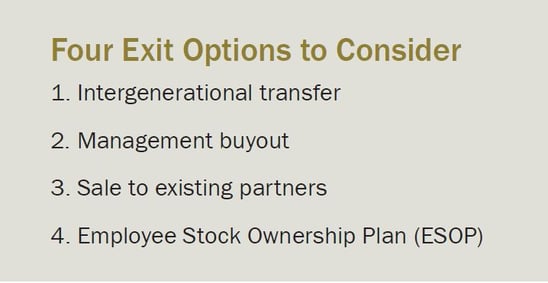4 min read
Selling a Business: Exit Strategies for Transitioning Your Business
 Anthony Nydegger
:
Aug 30, 2023 7:00:00 AM
Anthony Nydegger
:
Aug 30, 2023 7:00:00 AM

If you own a business, it is always important to think down the road – to have an end game in mind. The events of the past few years certainly brought this to the forefront. The pandemic forced millions of business owners to make life-changing decisions regarding their priorities, work obligations, and family relationships – difficult choices that ultimately resulted in reshaping and executing their succession and exit-planning strategies.
A 2021 survey of companies of various sizes across all industries found 97% of the high- and ultra-high net worth business owners polled agree the pandemic impacted or disrupted their business. A large majority (66%) of those surveyed admit the pandemic also accelerated their plans to retire or sell their business.¹
There are many ways to exit a business — some are common and some are unique. The following discussion gives an overview of the process for creating a structure, or mindset, around four inside transitional strategies.
Vetting the options on the table
Once you decide the time is right to sell your business, there are many financial and personal decisions you need to address.
As a business owner, no one understands better than you how crucial strategic planning is to your business. If you don’t have a written transition plan already in place, you can start the process by answering some basic questions to help guide your exit strategies. For example:

An overview of four inside exit options
The following is an overview of four primary inside exit options to consider as a means of establishing and articulating a process that works best for you and your business. Let’s take a look at the pros and cons of each.
(1) Intergenerational transfer
This exit option involves the transfer of closely held stock to direct family members, typically children. You can do this either by selling or gifting them the shares of your business. According to the Exit-Planning Institute (EPI), only 30% of family-owned businesses transition to the second generation and only 12% survive to the third.²
A 2021 survey of companies of various sizes across all industries found 97% of the high- and ultra-high net worth business owners polled agree the pandemic impacted or disrupted their business. A large majority (66%) of those surveyed admit the pandemic also accelerated their plans to retire or sell their business.¹
There are many ways to exit a business — some are common and some are unique. The following discussion gives an overview of the process for creating a structure, or mindset, around four inside transitional strategies.
Vetting the options on the table
Once you decide the time is right to sell your business, there are many financial and personal decisions you need to address.
As a business owner, no one understands better than you how crucial strategic planning is to your business. If you don’t have a written transition plan already in place, you can start the process by answering some basic questions to help guide your exit strategies. For example:
- What is the current net worth of your business?
- How much money would you like to get from the sale of your business?
- When would you like to sell?
- Will you receive enough money from the sale to either retire or move on to your next venture?
- How much money will you need after taxes to fund your desired lifestyle?
- What individual(s) are you considering in the transfer or sale of your business?
- Who are the trusted professionals and advisors you want on your transition team to help establish clear objectives and a well-constructed plan from beginning to end?

An overview of four inside exit options
The following is an overview of four primary inside exit options to consider as a means of establishing and articulating a process that works best for you and your business. Let’s take a look at the pros and cons of each.
(1) Intergenerational transfer
This exit option involves the transfer of closely held stock to direct family members, typically children. You can do this either by selling or gifting them the shares of your business. According to the Exit-Planning Institute (EPI), only 30% of family-owned businesses transition to the second generation and only 12% survive to the third.²
Pros:
In a management buyout, the management team utilizes the assets of the business to finance a significant portion – or all – of the purchase price from the owner looking to sell the business.
Pros:
(3) Sale to existing partners
This type of transaction only can happen if you have other partners in the business. The success of this transfer is predicated on the quality and durability of a Buy-Sell Agreement.
Pros:
(4) Employee Stock Ownership Plan (ESOP)
With this exit option, the business uses borrowed funds to acquire shares of stock from the owner and contributes the shares to a trust on behalf of the employees.
Pros:
How we can help
Selling a privately owned business doesn’t happen overnight. Commerce Trust can help you plan and navigate various exit strategies. Watch for the future release of the third article in this series where we will give an overview of outside transition options for your business. In the meantime, contact us if you are ready to sell your business, have questions about how to proceed, or need further information and guidance from our professionals who have helped countless other business owners.
- The legacy of the family business is preserved and continued.
- Your exit can be strategically planned over time.
- This option is typically low in transfer costs.
- You have more control over the time frame and direction of exit.
- There is minimal disruption as this is already in the continuity plan.
- Selling or gifting shares to your children could upset other family members.
- This option typically results in a lower sales price.
- Key employees (who are not family members) may not want to stay.
- Tradition might supersede better business strategy.
- This may be an easier route, but not necessarily the best exit option for you or your business.
In a management buyout, the management team utilizes the assets of the business to finance a significant portion – or all – of the purchase price from the owner looking to sell the business.
Pros:
- Key employees stay on and manage the business.
- The culture and knowledge of the business are preserved.
- This option facilitates a better organized, planned transition.
- Your current management might not be the best fit for the future strategic growth of the company.
- Buyers may use the capital of the business rather than outside sources.
- This option could result in a lower price from the sale of the business.
- Heavy seller financing can be a credit risk if you’re an owner who needs the money for retirement.
(3) Sale to existing partners
This type of transaction only can happen if you have other partners in the business. The success of this transfer is predicated on the quality and durability of a Buy-Sell Agreement.
Pros:
- The transaction is a smooth transition with no business interruption.
- The sale is planned out well in advance.
- The culture and dynamics of the business don’t necessarily change.
- This option is typically lower in cost.
- The sale is usually financed with insurance so liquidity for the purchase is always there.
- This type of transfer typically results in a lower sales price.
- Creative differences between partners can come into play.
- The Buy-Sell Agreement may restrict terms and selling options.
(4) Employee Stock Ownership Plan (ESOP)
With this exit option, the business uses borrowed funds to acquire shares of stock from the owner and contributes the shares to a trust on behalf of the employees.
Pros:
- Stock shares are purchased with pre-tax dollars by the ESOP.
- The business stays with the employees (and the culture remains intact).
- There are potential tax advantages to the selling business owner.
- This exit option may encourage employees to think and act like an owner.
- An ESOP is an employee benefit.
- Putting an ESOP in place can be complicated and costly.
- An ESOP is best suited for a gradual exit over time.
- An ESOP requires a securities registration exemption.
- When employees leave, the business is motivated to always buy back their shares.
How we can help
Selling a privately owned business doesn’t happen overnight. Commerce Trust can help you plan and navigate various exit strategies. Watch for the future release of the third article in this series where we will give an overview of outside transition options for your business. In the meantime, contact us if you are ready to sell your business, have questions about how to proceed, or need further information and guidance from our professionals who have helped countless other business owners.
¹ Executive Summary, “Succeeding Through Succession: Clarfeld | Citizens Private Wealth’s Success and Succession Survey,” https://www.businesswire.com/portal/site/home/news/
home/20210913005600/en/Pandemic-Prompted-Two-Thirds-of-High-Net-Worth-Business-Owners-to-Change-Succession-Plans-Clarfeld-Citizens-Private-Wealth-Finds,
accessed August 8, 2023.
² Yaqub, M. (CBC), BusinessDIT, Marcum LLP, “Baby Boomer Business Owner Statistics 2023: The Facts and the Trends,” https://www.businessdit.com/baby-boomerbusiness-
owner-statistics/, updated April 8, 2023.
The opinions and other information in the commentary are provided as of August 30, 2023. This summary is intended to provide general information only, and may be of value
to the reader and audience.
This material is not a recommendation of any particular investment or insurance strategy, is not based on any particular financial situation or need, and is not intended to
replace the advice of a qualified tax advisor or investment professional. While Commerce may provide information or express opinions from time to time, such information or
opinions are subject to change, are not offered as professional tax, insurance or legal advice, and may not be relied on as such.
Data contained herein from third-party providers is obtained from what are considered reliable sources. However, its accuracy, completeness or reliability cannot be
guaranteed.
Commerce Trust is a division of Commerce Bank.
INVESTMENT PRODUCTS: NOT FDIC INSURED | MAY LOSE VALUE | NO BANK GUARANTEE
